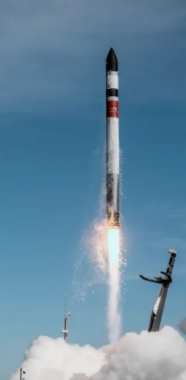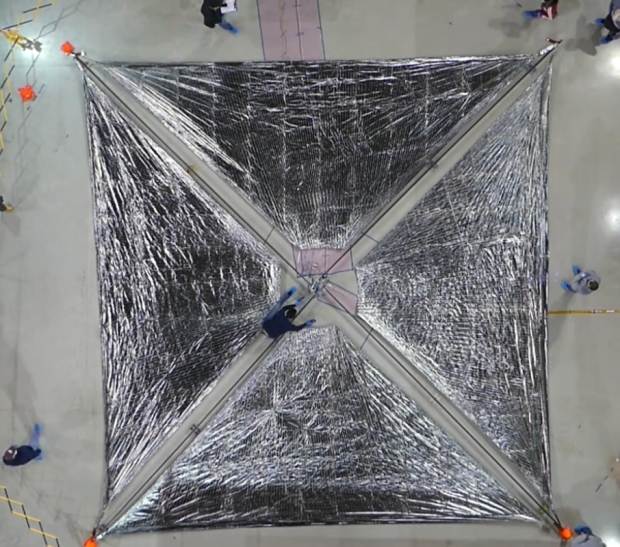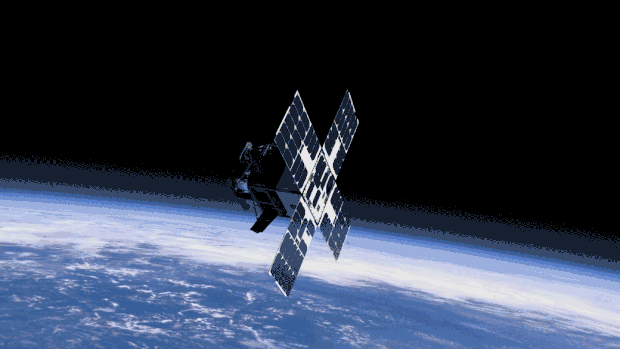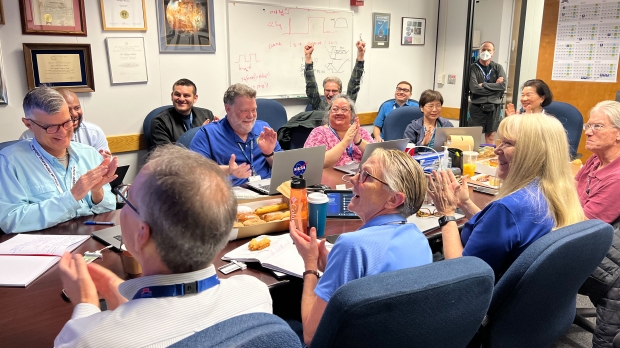ACS3: Refining Sail Deployment26 April 2024 | 9:37 am

Rocket Lab, a launch service provider based in Long Beach CA, launched a rideshare payload on April 23 from its launch complex in New Zealand. I’ve been tracking that launch because aboard the Electron rocket was an experimental solar sail that NASA is developing to study boom deployment. This is important stuff, because the lightweight materials we need to maximize payload and performance are evolving, and so are boom deployment methods. Hence the Advanced Composite Solar Sail System (ACS3), created to text composites and demonstrate new deployment methods.
The thing about sails is that they are extremely scalable. In fact, it’s remarkable how many different sizes and shapes of sails we’ve discussed in these pages, ranging from Jordin Kare’s ‘nanosails’ to the small sails envisioned by Breakthrough Starshot that are just a couple of meters to the side, and on up to the behemoth imaginings of Robert Forward, designed to take a massive starship with human crew to Barnard’s Star and other targets. Sail strategies thus move from using them as propulsive projectiles (Kare) to full-blown interstellar photon-catchers for high-speed star travel.
With ACS3, we’re at the lower end of the size spectrum and digging into such fundamental matters as composite materials and boom deployment engineering. Entertainingly, the Electron launch vehicle was named ‘Beginning of the Swarm,’ doubtless a nod to the primary payload, which is a South Korean imaging satellite that will be complemented by 10 similar craft in coming years. But I also like to think that ‘swarms’ of small solar sails like the twelve-unit (12U) CubeSat used for ACS3, will eventually offer options not only for near-Earth but also outer system observation and exploration. But first, we have to nail down those tricky deployment issues. Keats Wilkie is ACS3 principal investigator at NASA Langley in Hampton Virginia:
“Booms have tended to be either heavy and metallic or made of lightweight composite with a bulky design – neither of which work well for today’s small spacecraft. Solar sails need very large, stable, and lightweight booms that can fold down compactly. This sail’s booms are tube-shaped and can be squashed flat and rolled like a tape measure into a small package while offering all the advantages of composite materials, like less bending and flexing during temperature changes.”

Image: On 24 April 2024, Rocket Lab launched the ACS3 & NeonSat-1 missions from Onenui Station (Mahia Peninsula), New Zealand. In this image, engineers at NASA’s Langley Research Center test deployment of the Advanced Composite Solar Sail System’s solar sail. The unfurled solar sail is approximately 30 feet (about 9 meters) on a side. Credit: NASA Ames.
ACS3 reached its final orbit a little less than two hours after liftoff, after earlier deployment of the South Korean NEONSAT-1 via a kick stage that changed orbit for the second of the deployments. The craft is now roughly 1000 kilometers up, and if everything goes well, full deployment of the composite booms spanning the diagonals of the sail will give us an 80 square meter sail as bright as Sirius in the night sky. Digital cameras onboard should provide imagery of the sail before and during deployment. No signs of sail deployment yet but the satellite is being observed at numerous sites.
Still nothing from ACS3 on 2268 MHz, but an absolute rainbow of 2k4 packets on 401.5 via 2.5-turn helical omni! Decoded as 'Light-1' frames in GNU Radio / gr-satellites + upload to SatNogs. Fun pass from 1000 Km ALT whether S-Band makes an appearance or not pic.twitter.com/LDlfjm2Gkq
— Scott Chapman (@scott23192) April 25, 2024
The polymer from which the composite booms are made is reinforced with carbon fiber and flexible enough to allow it to be rolled for compact storage. According to Alan Rhodes, lead systems engineer for the mission at NASA Ames, seven meters of deployable booms can roll up into a shape that fits into the hand. Note too that these booms are 75 percent lighter than previous metallic deployable booms and should experience far less in-space thermal distortion during flight. A new tape-spool boom extraction system is being tested which will, engineers hope, minimize the possibility of the coiled booms jamming during the deployment. We shall see.

Animation: Deployment of the ACS3 sail. Credit: NASA Ames.
We’re getting pretty good at miniaturization, as shown by the fact that the 12-unit CubeSat carrying ACS3 into orbit measures roughly 23 centimeters by 34 centimeters, which makes it about the size of the microwave oven sitting on my kitchen counter. Refining the material and structure of the booms is another step toward lower-cost missions which we can eventually hope to deploy in networked swarms. Imagine a constellation of exploratory craft to targets like the ice giants. Larger sails using these technologies may eventually fly the kind of ‘sundiver’ missions we’ve often discussed here, deploying at perihelion for maximum thrust to deep space.

PLEASE UPDATE THE RSS FEED25 April 2024 | 8:00 am
The RSS feed URL you're currently using https://follow.it/centauri-dreams-imagining-and-planning-interstellar-exploration will stop working shortly. Please add /rss at the and of the URL, so that the URL will be https://follow.it/centauri-dreams-imagining-and-planning-interstellar-exploration/rss
Voyager 1: A Splendid Fix24 April 2024 | 1:28 pm
Although it’s been quite some time since I’ve written about Voyager, our two interstellar craft (and this is indeed what they are at present, the first to return data from beyond the heliosphere) are never far from my mind. That has been the case since 1989, when I stayed up all night for the Neptune encounter and was haunted by the idea that we were saying goodbye to these doughty travelers. Talk about naivete! Now that I know as many people in this business as I do, I should have realized just how resilient they were, and how focused on keeping good science going from deep space.
Not to mention how resilient and well-built the craft they control are. Thirty five years have passed since the night of that encounter (I still have VCR tape from it on my shelf), and the Voyagers are still ticking. This despite the recent issues with data return from Voyager 1 that for a time seemed to threaten an earlier than expected end to the mission. We all know that it won’t be all that long before both craft succumb to power loss anyway. Decay of the onboard plutonium-238 enabling their radioisotope thermal generators (RTGs) means they will be unable to summon up the needed heat to allow continued operation. We may see this regrettable point reached as soon as next year.
But it’s been fascinating to watch over the years how the Voyager interstellar team manages the issue, shutting down specific instruments to conserve power. The glitch that recently occurred got everyone’s attention in November of 2023, when Voyager 1 stopped sending its normal science and engineering back to Earth. Both craft were still receiving commands, but it took considerable investigation to figure out that the flight data subsystem (FDS) aboard Voyager 1, which packages and relays scientific and engineering data from the craft for transmission, was causing the problem.
What a complex and fascinating realm long-distance repair is. I naturally think back to Galileo, the Jupiter-bound mission whose high-gain antenna could not be properly deployed, and whose data return was saved by the canny use of the low-gain antenna and a revised set of parameters for sending and acquiring the information. Thus we got the Europa imagery, among much else, that is still current, and will be complemented by Europa Clipper by the start of the next decade. The farther into space we go, the more complicated repair becomes, an issue that will force a high level of autonomy on our probes as we push well past the Kuiper Belt and one day to the Oort Cloud.

Image: I suppose we all have heroes, and these are some of mine. After receiving data about the health and status of Voyager 1 for the first time in five months, members of the Voyager flight team celebrate in a conference room at NASA’s Jet Propulsion Laboratory on April 20. Credit: NASA/JPL-Caltech.
In the case of Voyager 1, the problem was traced to the aforesaid flight data subsystem, which essentially hands the data off to the telemetry modulation unit (TMU) and radio transmitter. Bear in mind that all of this is 1970s era technology still operational and fixable, which not only reminds us of the quality of the original workmanship, but also the capability we are developing to ensure missions lasting decades or even centuries can continue to operate. The Voyager engineers gave a command to prompt Voyager 1 to return a readout of FDS memory, and that allowed them to confirm that about 3 percent of that memory had been corrupted.
Culprit found. There may be an errant chip involved in the storage of memory within Voyager 1’s FDS, possibly a result of an energetic particle hit, or more likely, simple attrition after the whopping 46 years of Voyager operation. All this was figured out in March, and the fix was determined to be avoiding the now defunct memory segment by storing different portions of the needed code in different addresses in the FDS, adjusting them so that they still functioned, and updating the rest of the system’s memory to reflect the changes. This with radio travel times of 22 ½ hours one way.
The changes were implemented on April 18, ending the five month hiatus in normal communications. I hadn’t written about any of the Voyager 1 travails, more or less holding my breath in hopes that the problem would somehow be resolved. Because the day the Voyagers go silent is something I don’t want to see. Hence my obsession with the remaining possibilities for the craft, laid out in Voyager to a Star.
Engineering data is now being returned in usable form, with the next target, apparently achievable, being the return of science data. So a fix to a flight computer some 163 AU from the Sun has us back in the interstellar business. The incident casts credit on everyone involved, but also forces the question of how far human intervention will be capable of dealing with problems as the distance from home steadily increases. JHU/APL’s Interstellar Probe, for example, has a ‘blue sky’ target of 1000 AU. Are we still functional with one-way travel times of almost six days? Where do we reach the point where onboard autonomy completely supersedes any human intervention?
